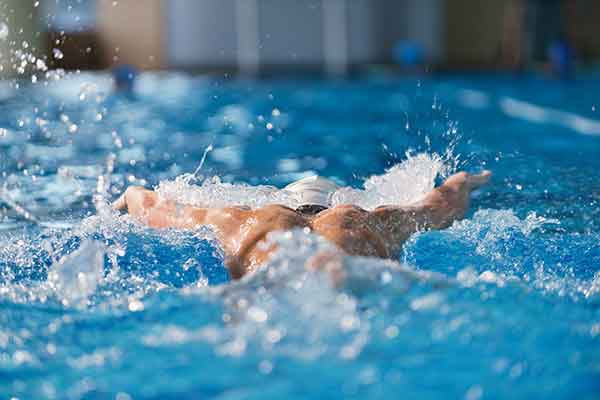Swimming

Swimming is probably the closest you can get to a perfect form of exercise. It is non-weight bearing and places no stress on the bones and joints. It strengthens your entire body while providing an excellent cardiovascular workout.
The best part of swimming is that it allows you to set the pace – it can be as strenuous as a sprint or as soothing as a stretch.
You don’t need a perfect stroke to get that feel-good sensation in the water. For some the thrill of being in water is the weightlessness; the way the water envelops the body and cools you off in the heat of the summer. For others, it is a vigorous body-friendly workout, burning calories and strengthening the muscles.
Do you know?
- The body is made of 60 to 70 percent water.
- The fetus is developed in a watery environment.
- Water has amazing healing benefits on the body and mind.
- Water exercises and water therapy are used to cure many ailments.
SWIMMING VERSUS RUNNING
Compare swimming to running: Runners’ legs and feet have to withstand a gravitational force that is two to three times their body weight each time their foot strikes the ground. Swimming, on the other hand, places almost no stress on the joints, while having the ability to provide as intense a workout as running.
On an average, one hour of swimming can burn about as many calories as running six miles an hour.
CALORIES BURNED
Swimming burns calories at a rate of about 3 calories per mile per pound of body weight. If you weigh 150 pounds, and it takes you 30 minutes to swim one mile, you will burn 900 calories in one hour. However, this requires very good stamina and speed.
INTENSITY
If you are thinking of taking up swimming, take the plunge! The good thing about swimming is that the water’s resistance allows you to control the intensity of the workout. The harder you push yourself against this resistance, the greater the challenge. This means that if you want a rigorous workout, moderate workout or just a relaxing time-out, it is up to you. You control speed, resistance and effort.
THE PERFECT CROSS-TRAINING SPORT
- Regular swimming builds endurance, muscle strength and cardiovascular fitness. It can serve as a cross-training element to your regular workouts.
- Runners, cyclists, in-line skaters and athletes of all types benefit from swimming because it can complement their training routine.
- People who are obese or have back or joint problems, are often advised to take up swimming because of its low-impact qualities
Caution
Be aware of the depth of water before going in. Know where the pool ladder and steps are. Pool chemicals can irritate and dry the skin and hair, so shower immediately after your swim; and make sure you moisturize the skin and condition hair.
When swimming in the ocean or lakes, watch for rocks, pollution, currents, and sudden changes in water temperature.
THE FOUR COMPETITIVE SWIMMING STROKES
- Freestyle / crawl
- Backstroke
- Butterfly
- Breaststroke
Not all swimming strokes have equal aerobic benefits. The butterfly uses the greatest amount of energy, followed closely by the freestyle and backstroke. The breaststroke and elementary backstroke have less of an aerobic impact because of the glide phase in which most people tend to relax. Yet, swimmers using these strokes can reap significant aerobic gains if they swim continuous laps.
TRAINING TIPS
- Warm up in the water. Before you begin the session, swim two or three slow lengths, varying your strokes.
- Cool down at the end of the session. Do two lengths at a comfortable pace, then dry off and follow a basic cool-down routine.
- As you swim, think about keeping your body in a straight line from head to hips to legs. All parts of the body are aligned and integrally linked.
- Kick from the hips, not from the knees. All arm movements should be initiated from the shoulders, not from the elbows.
- Breathe properly: breathe out through your mouth while your head is in the water; and turn your head to one side, so your ear is by your shoulder when you breathe in.
- Keep your movements smooth and rhythmic.
MASTERING THE WATER
Improve strength and technique by practicing with flotation boards. Alternate strokes. Swim one length of a stroke you find more difficult, then swim two lengths of a stroke that you find easier.
Interval train. Instead of swimming up and down at the same speed, vary your pace. For example, swim one length very fast, then two lengths at a more leisurely pace.
OPTIONAL ACCESSORIES
These accessories can assist you while you swim and help improve technique.
- Swimming boards / Kickboards
- Flippers
- Pull-buoys
- Paddles
Useful tools to monitor speed are:
- The tempo trainer
- The aqua pacer
- The pace clock or stop watch






1 Comment
Cameron Nankervis
Your SEO is Dying—Here’s Why:
Google isn’t the only game in town anymore—AI-powered search and voice assistants are taking over. If your site isn’t optimized, your traffic will vanish.
I’ve helped businesses recover lost rankings and future-proof their visibility. Let’s make sure you’re not left behind.
Shoot me an email at [email protected] for a free consultation, or check out Marketer2025.com for details.